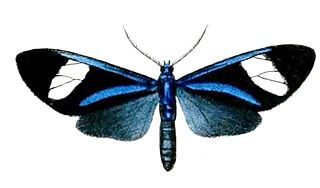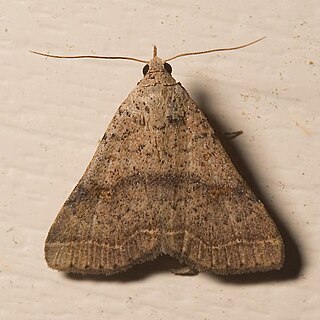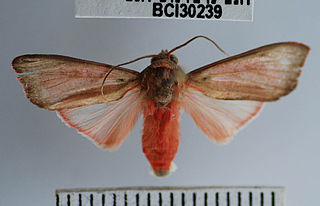Ammalo is a genus of moths in the subtribe Phaegopterina in the family Erebidae. The genus was erected by Francis Walker in 1855.
Calonotos is a genus of moths in the subfamily Arctiinae. The genus was erected by Jacob Hübner in 1819.

Euagra is a genus of moths in the subfamily Arctiinae. The genus was erected by Francis Walker in 1854.
Lepidokirbyia is a genus of moths in the family Erebidae. The genus was described by Travassos in 1943.
Melora is a monotypic moth genus in the subfamily Arctiinae. Its single species, Melora amygdaloides, is found in Brazil. Both the genus and species were first described by Francis Walker in 1855.
Argyrosticta is a genus of moths of the family Noctuidae. The genus was erected by Jacob Hübner in 1821.

Bleptina is a genus of litter moths of the family Erebidae. It was erected by Achille Guenée in 1854.

Thagona is a genus of moths in the subfamily Lymantriinae. The genus was described by Möschler in 1883.

Rothschildia jacobaeae is a moth of the family Saturniidae first described by Francis Walker in 1855. It is endemic to Argentina and Brazil.

Halysidota interlineata is a moth of the family Erebidae first described by Francis Walker in 1855. It is found in Costa Rica, Guatemala, Panama, Belize, Colombia, Venezuela, Surinam, French Guiana, Brazil and Uruguay.
Amaxia pardalis is a moth of the family Erebidae. It was described by Francis Walker in 1855 and is the type species of the genus Amaxia. It is found in Brazil, Suriname, Costa Rica and Mexico.

Dysschema marginalis is a moth of the family Erebidae first described by Francis Walker in 1855. It is found in Venezuela, Ecuador and Colombia.

Elysius conspersus is a moth of the family Erebidae. It was described by Francis Walker in 1855. It is found in Panama, Colombia, Venezuela, Peru, Brazil, Paraguay and Ecuador.

Eucereon pica is a moth of the subfamily Arctiinae. It was described by Francis Walker in 1855. It is found in Costa Rica, Peru and Rio de Janeiro, Brazil.

Melese incertus is a moth of the family Erebidae. It was described by Francis Walker in 1855. It is found in French Guiana, Suriname, Guyana, Brazil, Venezuela, Trinidad, Peru, Bolivia and Panama.
Pelochyta cinerea is a moth of the family Erebidae. It was described by Francis Walker in 1855. It is found in Costa Rica, Panama, Colombia, Venezuela, Ecuador, Bolivia and Brazil.
Scaptius ditissima is a moth in the family Erebidae. It was described by Francis Walker in 1855. It is found in Panama, Brazil, Peru and Ecuador.
Trichromia repanda is a moth in the family Erebidae. It was described by Francis Walker in 1855. It is found in French Guiana, Brazil, Amazonas, Venezuela, Ecuador, Peru and Bolivia.
Trichura latifascia is a moth in the subfamily Arctiinae. It was described by Francis Walker in 1854. It is found in Panama, Colombia, French Guiana and Pará, Brazil.
Quentalia vittata is a moth in the family Bombycidae. It was described by Francis Walker in 1855. It is found in Brazil.








